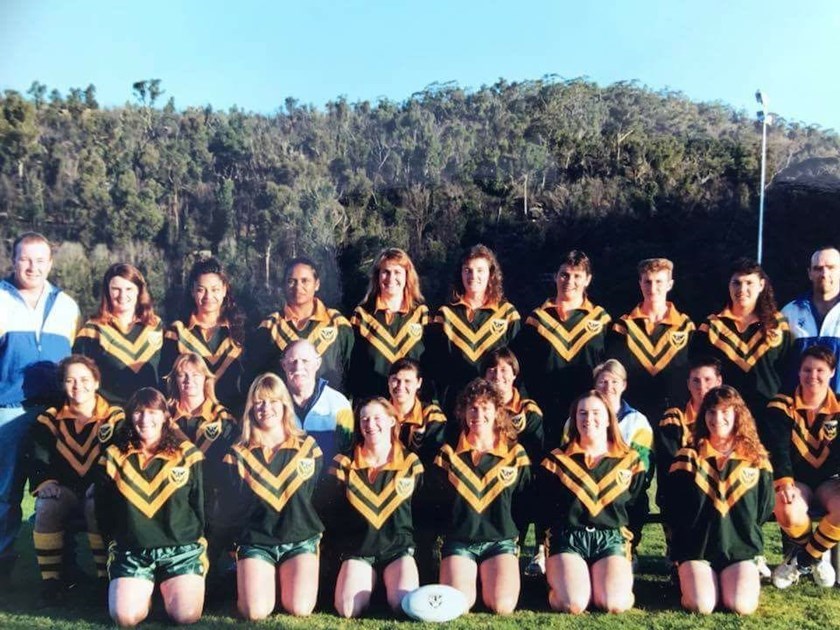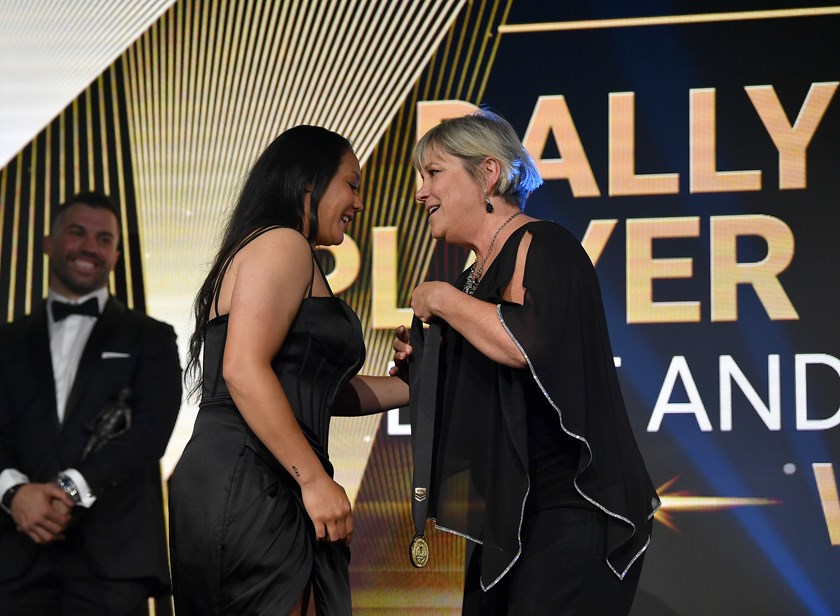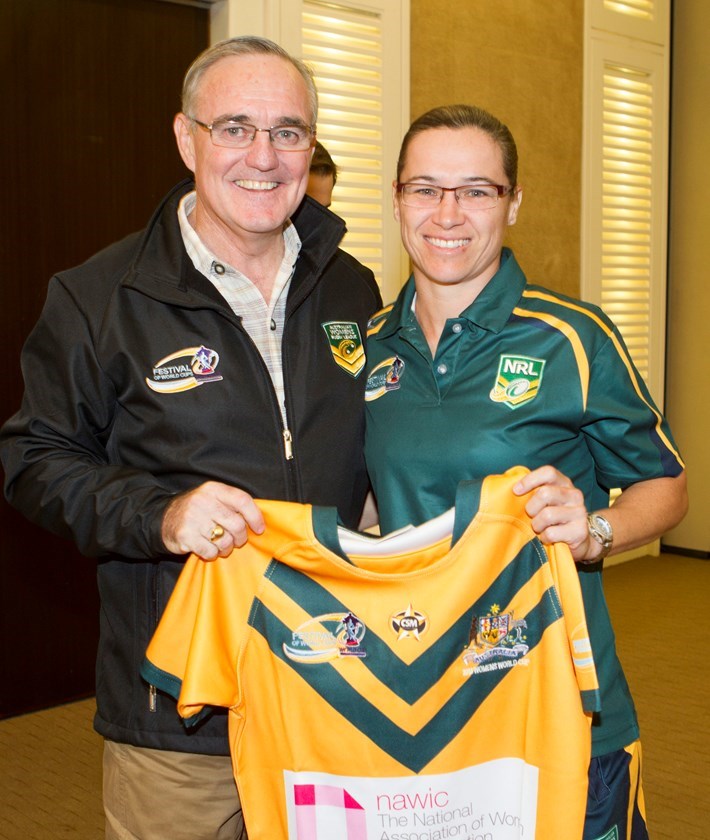Australia’s first female rugby league dual international, Julie Porter, was also a Matildas pioneer.
Nat Dwyer, Jillaroo No.1 and the first Australian women’s captain, only took up the game after reading an advertisement for players in a local newspaper.
Tarsha Gale, after whom the first NSWRL girls pathways competition was named, told her parents she was playing another sport while she was instead starring as a teenage rugby league halfback in Wollongong.
These are some of the stories about how the members of the first Jillaroos team in 1995 came to be trailblazers for the 300 players in this season’s NRLW and those coming through the ranks behind them.
Andrew Abdo launches the NRLW
“It is magical to see where the game has got to now,” Porter said. “Somebody has got to be the pioneers and lay the foundation, but it is nice to see it has been built on, so that is great.
“I just basically played rugby league to prove a point that I could play. I wanted to play for the Thirroul Butchers as a kid, and I just wasn’t allowed to.”
Instead, Porter joined Thirroul Soccer Club and blazed a trail in that sport, becoming Matilda No.20 in 1981 and scoring four goals in six international appearances for Australia.
As Illawarra’s first Matildas representative, a trophy has been named in her honour, with teams in the Football South Coast Women’s Premier League playing for the Julie Porter Cup.
Porter’s rugby league exploits are less known but just as significant as she became Jillaroo No.16 and played lock in the 1995 Test, after joining Bulli Eagles with former soccer team-mates Julie McGuffie and Sherilee Moulds.
“Julie was an exceptional talent, and obviously she pioneered both codes,” Gale said. “Representing your country for the first time can be daunting but because Julie had done it all in soccer, she had that experience and helped us.

“She was a lot of fun off the field and very handy on the field. We played her at fullback to start with because she could read a game well and organise us around the park.”
Gale and Dwyer were also recruited to play for Bulli under coach Simon Sowry, who took charge of the Illawarra representative team.
Along with Porter, McGuffie and Moulds, Gale and Dwyer were selected to play against New Zealand at Lidcombe Oval on July 1, 1995, in Australia’s first official women’s Test, in which the Jillaroos suffered a narrow 18-14 loss.

“About 60 per cent of that first Australian team would have been from Illawarra,” Dwyer said. “We started the comp in 1993, but it wasn’t until 1995 that we had a proper selection process for the Australian team.”
The inaugural Jillaroos side was chosen after a tournament at Redfern Oval on the June long weekend, featuring representative teams from Canberra, Illawarra, Sydney and Brisbane.
“We were a pretty good side back then, I don’t think it was until 1998 that Sydney knocked us off,” Dwyer said.
“A lot of the girls came from soccer. I just saw an ad in the local paper wanting girls to play football, so I just went down to the local football club and the girls were already there.
"They were getting a side together. I just started playing and I didn’t look back from there.”
Despite her brothers Scott and Brett having enjoyed distinguished playing careers, Gale’s parents wouldn’t allow her to play league, so she played touch football – among a myriad of sports - and was approached to play for Bulli.

“I thought ‘mum and dad think I’m playing netball and tennis on a Saturday, so I will whip down the Gong and play this game’ and I was lucky enough to crack a team that had the likes of Nat Dwyer, Julie McGuffie and Julie Porter.
“The first time I ran the ball and they had to tackle me on the ground, that was it for me. I just could not get enough of it. I fell in love with the game.”
With the outbreak of the Super League war in 1995, there was little financial support for the fledgling women's game and players virtually had to pay to play, including at international level.
“When I first threw on the boots, to me it was just a social sport, and I certainly didn’t think it would be where it is today,” said Dwyer, who has a medal named in her honour for player of the match in the U19s State of Origin.
"We had jerseys that were two times too big for us, and sometimes the shorts didn’t fit us either. People were selling cars to try and make the money that was needed to play.
"You look at team photos now and you’ve got 20 players and about 10 coaching staff. I think we had a coach, an assistant coach and a manager.
“It’s a great to see that there is a pathway for the women now and young girls don’t have to stop when they are 12, and then wait until they are 18 to play again.
"Hopefully not too far down the track we might see every NRL club with an NRLW team and players becoming fulltime professionals.”

For Porter, the financial hardships endured by players were similar to those she had experienced playing for the Matildas.
“It was early days in both sports and the stories are much similar," Porter said.
"It probably wasn’t as intense with the rugby league because we did have a bit of funding, but it was basically pay your own way in both sports through the usual Lamington drives and chook raffles.
“All of women’s sport has gone through the roof, it is incredible, because the opportunities are there now.
"I would love to have played State of Origin, that was amazing this year, but nonetheless my time was my time, and you still get that badge on your jumper. They were halcyon days for us."
Sky Blues v Maroons – Game 2, 2024
While there is a buzz in women's rugby league circles that the first six female inductees into the NRL Hall of Fame will be honoured at the SCG on August 21, Gale said there were some unsung heroes who also deserved recognition.
As pioneers of the game, it was largely left to the players to drive the direction of the game and Gale said Laurel Savage and former Jillaroos halfback Linda Pearson were two women whose work behind the scenes had a huge impact.
"We all sat on committees, and it took the people who were playing the game to organise the competitions and to try and get backing," Gale said.
"Linda Pearson was instrumental in getting the Illawarra league together and Laurel Savage was instrumental in getting us affiliated with the ARL.
"Because of the Super League problem, no-one wanted to touch us, but she was tenacious, and we wouldn’t be where we are without her.
"From 1995 we had Test matches every single year, which took a lot of organisation, particularly when you are dealing with a sport that is not recognised by the general public.
"The players themselves were not only trailblazers by playing in the first Test, they were also behind the scenes doing all the work and there were some amazing, strong, determined women involved."




